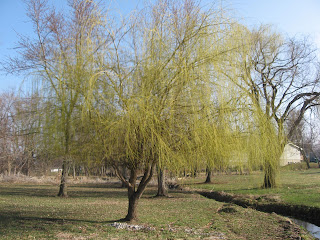Say the word
apron and what comes to mind? The word itself is Middle English derived from the Middle French
naperon, diminutive of
nape cloth, modification of Latin
mappa napkin.
Apron was first used in the 15th Century.
I first think of the half aprons my mother always wore when I was a child. Often they were made out of the scraps she had left over from sewing a dress or skirt and two or more fabrics might be combined in order to have enough material which sometimes resulted in some pretty wild aprons. If she were making a little fancier apron, a bottom row of diagonally cut pieces would be sewn on and embellished with rickrack.
The aprons like my Grandmother Lynam is wearing in this picture with Dad as a child were almost like wearing a second dress. I call this an over all apron, though I'm not sure that is the right term.
Grandma had taken her apron off for this picture with Dad and Ron as a baby, but Great Grandma Aggie still had hers on. It is hard to find old pictures of women in their aprons because they did take them off for picture taking.
Aprons began as protective clothing for men, such as blacksmiths and farriers. It wasn't until the 17th Century that women began wearing them. Most women only had two or three dresses. Aprons helped keep the dress clean and were generally easier to launder.
In the 1950's, the
cobbler apron became fashionable. I can remember Mom making and wearing a few like the ones pictured on this old pattern envelope. Aprons not only kept the housewife's dress clean, they were handy to carry things in - eggs from the hen house, produce from the garden, apples from the orchard.
This is not a picture of Grandma Ridnour's apron, but I swear she had one exactly like this. It is the style she usually wore and the material looks so familiar. Perhaps it was made from a feed sack as many of Grandma's were. Aprons were not only protective coverings, they could also be used as pot holders or dust cloths, to wipe sweat from a brow or tears from a face and they were an excellent place for a shy child to hide behind.

When I learned to iron, handkerchiefs and aprons were what I learned on. And when I learned to sew, an apron was my first Home-Ec project as a high school freshman. I still remember the green, white and grey striped fabric I bought for it in Biggars basement. It was twenty-five cents a yard and took less than 2/3's a yard. First we had to sew the band depending on our waist size and then gather the fabric and sew it onto the band before adding the ties and a pocket and hemming it. I remember sewing the gathered material onto the band and sewing on the pocket as being the hardest to do. I think Mrs. Poindexter gave me a grade of a C or maybe C+. I didn't like Home-Ec - not the sewing, not the cooking, nor the meal planning - not even the section on child care. It was a required course I just had to get through.
I never wore aprons much though I started married life with the one I made in high school plus a few more made for me by my Grandmothers. I got started collecting them in the '70's and wearing them once in awhile. My favourite style was the
butcher or
grocer style. It looped or tied around the neck and waist, was mid-thigh in length and had a pocket or two and it was usually made from a heavier material like duck cloth or canvas. I also had a thing for
carpenter's and
waiter's aprons.
I hunted out some of those aprons for the picture above. You can tell by the wrinkles they have been packed away a long time. (Probably should have
practiced my ironing skills Mom taught me.) Most of them I found at garage sales. The pretty coral colored one says
3M, next one is printed
Red Rose Animal Feeds, underneath those two, the white one offers
Special Rates for Bar Mitzvahs and Weddings. The blue, white and red one reads
Parisian Extra Sour in the large black letters and
World Famous San Francisco Sourdough Since 1856 in the circle on the blue top. Next to it is one of the two
Organic Gardening and Farming aprons I have - probably bonuses for subscribing to the magazine. The blue and white striped one says simply
Paris Bistro while the little servers' bar apron barely visible at the top says
Applegate's Landing. I don't remember the Applegate's Landing restaurant chain from the '70's. They may not have made it to Omaha or Des Moines, though there were some locations in Kansas. Apparently their feature was a salad bar set up in the bed of a Ford Model A pickup truck. The burgundy apron barely visible underneath is the only plain one in the picture.
I had many, many more aprons before downsizing and moving, but I didn't keep all of them nor any of my Mom's homemade ones, though I think some of the granddaughters did. And that apron from Home-Ec was long gone. If I ever do want to wear an apron again, I still have plenty to choose from. Wearing an apron and baking cookies seem to go hand-in-hand......if I were just that kind of Grandma......





















































